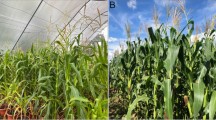Abstract
The conventional deduction procedure of computation of soil (α) and fertilizer (β) nutrient efficiencies for the amount of fertilizer required for specified yield targets does not make provision of the amount of soil nutrient derived by crops from the available pool of soil nutrients not accounted for in the amount extracted by a soil test procedure. The derivation of two mathematical models, viz., Tamil Nadu Agricultural University Model I [TNAU Model I] and Model II [TNAU Model II] is reported in this paper which aim at computing the soil (α) and fertilizer (β) nutrient efficiencies not accounted for by the conventional method.
In the case of TNAU Model I, the relationship between the nutrient uptake (U) and the soil (S) and the fertilizer (F) nutrients was established by assuming a functional relationship of the type U =αS +βF such that 0 ⩽α ⩽ 1 and 0 ⩽β ⩽ 1. In TNAU Model II the same relationship was established as U =αS +βF +γ such that 0 ⩽α ⩽ 1, 0 ⩽β ⩽ 1 andγ > 0. The termγ in the latter model is a measure of the amount of soil nutrient the crop absorbs from a slowly available pool of nutrients not accounted for in the amounts extracted by the soil test procedure employed or applied through fertilizer.
The field verification of these models is reported elsewhere.
Similar content being viewed by others
References
Aggarwal RK and Ramamoorthy B (1978) A statistical approach for recommending fertilizer doses for targetted yields and maintenance of soil fertility in a crop sequence of alluvial soils of India. Curr Agric 2(3–4): 1–5
Maruthisankar GR, Velayutham M, Reddy KCK and Singh KD (1983) A new method for better estimation of soil and fertilizer efficiencies. Indian J Agric Sci 53: 314–319
Mombiela F, Nicholaides III JJ and Nelson A (1981) Method for determining the appropriate mathematical form for incorporating soil test levels in fertilizer response models for recommendation purposes. Agron J 73: 937–941
Murugappan V, Kothandaraman GV, Palaniappan SP and Manickam TS (1988) Fertilizer doses for specified yield targets. II. Field verificiation of mathematical models for the estimation of soil and fertilizer nutrient efficiencies. Fert Res ibid
Ramamoorthy B, Narasimhan RL and Dinesh RS (1967) Fertilizer application for specified yield targets of Sonora 64 (wheat). Indian Fmg 17: 43–45
Rao SS (1979) Optimization theory and applications. Wiley Eastern Ltd, New Delhi
Truog E (1960) Fifty years of soil testing. Trans 7th Int. Congr Soil Sci 4: 46–52
Velayutham M, Reddy KCK and Maruthisankar GR (1978) Annual Report of the coordinated Cell, 1975–77, Soil Test Crop Response Project, Indian Council of Agricultural Research, New Delhi
Author information
Authors and Affiliations
Rights and permissions
About this article
Cite this article
Murugappan, V., Kothandaraman, G.V., Palaniappan, S.P. et al. Fertilizer requirements for specified yield targets. I. Theoretical derivation of mathematical models for the computation of soil and fertilizer nutrient efficiencies. Fertilizer Research 18, 117–126 (1988). https://doi.org/10.1007/BF01049508
Received:
Accepted:
Issue Date:
DOI: https://doi.org/10.1007/BF01049508




